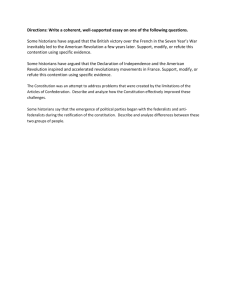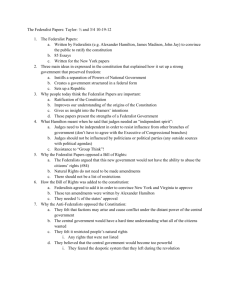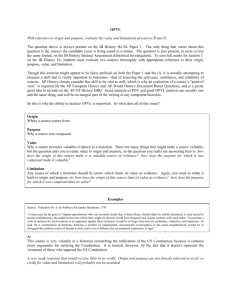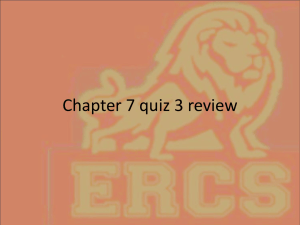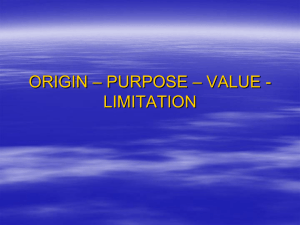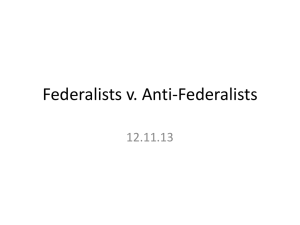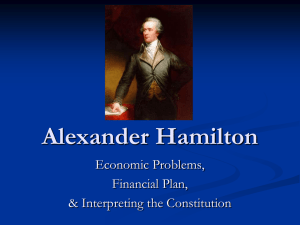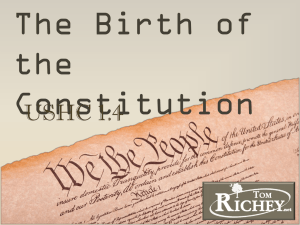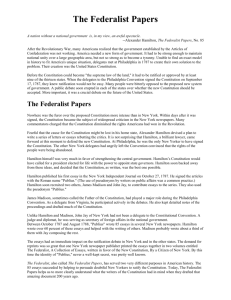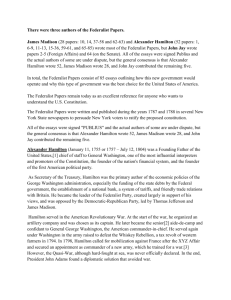File
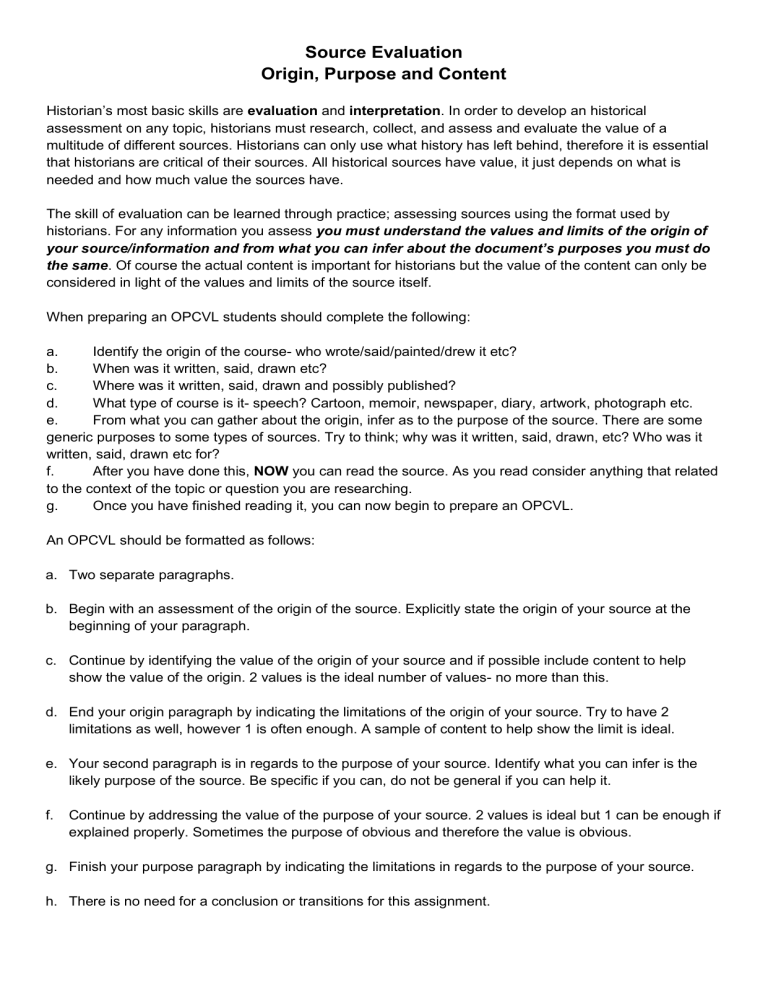
Source Evaluation
Origin, Purpose and Content
Historian ’s most basic skills are evaluation and interpretation . In order to develop an historical assessment on any topic, historians must research, collect, and assess and evaluate the value of a multitude of different sources. Historians can only use what history has left behind, therefore it is essential that historians are critical of their sources. All historical sources have value, it just depends on what is needed and how much value the sources have.
The skill of evaluation can be learned through practice; assessing sources using the format used by historians. For any information you assess you must understand the values and limits of the origin of your source/information and from what you can infer ab out the document’s purposes you must do the same . Of course the actual content is important for historians but the value of the content can only be considered in light of the values and limits of the source itself.
When preparing an OPCVL students should complete the following: a. b. c. d.
Identify the origin of the course- who wrote/said/painted/drew it etc?
When was it written, said, drawn etc?
Where was it written, said, drawn and possibly published?
What type of course is it- speech? Cartoon, memoir, newspaper, diary, artwork, photograph etc. e. From what you can gather about the origin, infer as to the purpose of the source. There are some generic purposes to some types of sources. Try to think; why was it written, said, drawn, etc? Who was it written, said, drawn etc for? f. After you have done this, NOW you can read the source. As you read consider anything that related to the context of the topic or question you are researching. g. Once you have finished reading it, you can now begin to prepare an OPCVL.
An OPCVL should be formatted as follows: a. Two separate paragraphs. b. Begin with an assessment of the origin of the source. Explicitly state the origin of your source at the beginning of your paragraph. c. Continue by identifying the value of the origin of your source and if possible include content to help show the value of the origin. 2 values is the ideal number of values- no more than this. d. End your origin paragraph by indicating the limitations of the origin of your source. Try to have 2 limitations as well, however 1 is often enough. A sample of content to help show the limit is ideal. e. Your second paragraph is in regards to the purpose of your source. Identify what you can infer is the likely purpose of the source. Be specific if you can, do not be general if you can help it. f. Continue by addressing the value of the purpose of your source. 2 values is ideal but 1 can be enough if explained properly. Sometimes the purpose of obvious and therefore the value is obvious. g. Finish your purpose paragraph by indicating the limitations in regards to the purpose of your source. h. There is no need for a conclusion or transitions for this assignment.
*Please see the website for a chart of the generic values and limitations of a collection of types of sources.
You CANNOT simply state what is on the chart- it must be manipulated to include the contextual knowledge you have. Generality is bad when it comes to assessing sources.
*Also, BIAS is not a value or limit and should never be mentioned. All historical information has bias.
Consider what it is about the author’s perspective that is valuable and/or limiting. Bias is not a problem, as long as we assess it.
The example below is a less extensive type of OPCVL, similar to a short answer question:
Source: Federalist No. 6, by Publius (Alexander Hamilton), 1787.
“A man must be far gone in Utopian speculations who can seriously doubt that, if these States should either be wholly disunited, or only united in partial confederacies, the subdivisions into which they might be thrown would have frequent and violent contests with each other. To presume a want of motives for such contests as an argument against their existence, would be to forget that men are ambitious, vindictive, and rapacious. To look for a continuation of harmony between a number of independent, unconnected sovereignties in the same neighborhood, would be to disregard the uniform course of human events, and to set at defiance the accumulated experienc e of ages.”
OPCVL #1:
Federalist No. 6, written by Alexander Hamilton in 1787 is a primary source. Since Hamilton was there, the source is of value to a historian. He wrote the Federalist Papers in order to convince people to ratify the US
Constitution, though, so he may have exaggerated some of the document’s benefits in order to win supporters. Because of this, historians may not get a clear picture of whether he believed that there were any weaknesses in the new Constitution.
OPCVL #2:
Federalist No. 6, a part of the Federalist Papers, written by Hamilton, Madison, and Jay in 1787-88 are of great value to historians because they contain the thoughts of three key members of the US Constitutional
Convention, therefore a historian studying the founding of the republic can gain insight into the minds of three of the founders (or one, in the case of Federalist No. 6). As their purpose was to convince Americans to support ratification of the Constitution, they clearly explain the strengths of the Constitution, giving a historian insight as to what three founders viewed as strengths of the framework of government that they had created. It is limited, though, by the fact that it doesn’t really give any arguments from the Anti-
Federalists, telling historians little about the reasons why they opposed the US Constitution.
OPCVL #3:
This source is very valuable to a historian researching the ratification of the US Constitution, because it contains many arguments for ratifying the Constitution. It is limited, however , by the fact that it doesn’t represent the viewpoint of those who opposed the US Constitution.
OPCVL #4:
This source by Alexander Hamilton is valuable because Hamilton lived in the United States at the time, and so knew very well the dangers facing the United States. He is writing Federalist Number 6 to explain that if the states do not unite, they will fight, and so this source is valuable to a historian studying the early republic.
OPCVL #5:
This source, written by Alexander Hamilton in 1787 for the purpose of convincing Americans to support ratification of the new US Constitution, is extremely valuable to historians researching the early period of the republic. A key item of value is that it contains many reasons for ratifying the Constitution. It is limited, however, by the fact that it doesn’t represent the viewpoint of those who opposed the US Constitution.
Example OPCVL from a Historical Investigation- This is a better example to abide by. Notice the format and the way the author suggests values and limitations with sentence frames.
The second source evaluated in depth is Mary Anderson’s 1944 address American Economic
Association “The Postwar role of American women”, which was delivered in March, 1944. The origin of this source is valuable because the address was delivered by the head of the Women’s Bureau of the
Department of Labor, and therefore provides an insight into the views of a well-known figure regarding women’s employment and post-war plans. Additionally, the date of delivery of the address, 1944, indicates that the source allows for a valuable understanding of contemporary views on women’s employment.
However, this date is also a limitation, for it suggests that the source, having been written before the completion of the war, is likely t o fail to analyze extensive research on women’s employment. In terms of origin, the source is also limited in that Anderson was herself a former factory worker and was “ particularly well attuned to the thinking of female employees” (Weatherford 256), indicating that she might have tended to shape the address according to her views, and, consequently, may have provided a slightly subjective insight into government plans.
The purpose of this source is to underscore the importance of the adoption of measures to secure the position of women in the American post-war workforce. The address therefore provides a valuable insight into government plans at the time. The source is, however, limited in its purpose in that the address, having been written to convince ot hers of Anderson’s point of view, perhaps omits some ‘inconvenient truths’ about the government’s views, merely describing encouraging plans for female workers.
_____________________________________________________________________________________
Criteria:
Origin:
Value-
Value-
Limit-
Limit-
Content-
Purpose:
Value-
Value-
Limit-
Limit-
Content-
